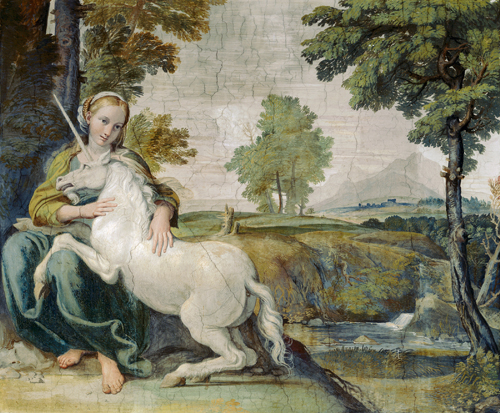
Your complimentary articles
You’ve read one of your four complimentary articles for this month.
You can read four articles free per month. To have complete access to the thousands of philosophy articles on this site, please
Articles
Leibniz on Unicorns
Dean Ericksen finds something strange in his cabinet of philosophical curiosities.
Saul Kripke may have argued that unicorns could not possibly exist, but if you’re personally unconvinced, you’d be in good company. When he wasn’t busy independently inventing infinitesimal calculus and devising his famous theodicy, Gottfried Wilhelm Leibniz (1646-1716) found time to write about unicorns in what would become Protogaea (1749).

Leibniz’s ‘unicorn’, 1749
Leibniz intended for Protogaea to serve as a preface to a larger project, a history of the House of Brunswick. But Protogaea was an ambitious undertaking in its own right. As Leibniz put it in the preamble, “those who would trace our region back to its beginnings must also say something about the original appearance of the earth, and about the nature of the soil and what it contains.” In other words, Leibniz’s little preface would be nothing less than a history of the earth itself.
Included in this history is a one-paragraph section entitled ‘The unicorn’s horn, and an enormous animal unearthed in Quedlinburg.’ The section begins on a skeptical note, with Leibniz reporting that ‘unicorn horns’ had been shown to “come from fish of the Polar Sea” [ie narwhals, Ed] and that fossil unicorns likely have the same origin. “Nevertheless,” Leibniz writes, unicorns do in fact exist: “we should not disguise the fact that a four-footed unicorn the size of a horse has been found in Abyssinia, if we can believe the Portuguese Hieronymus Lupus and Balthazar Tellesius.” What’s more, the discovery of skeletal remains also suggested the existence of unicorns: “The skeleton that was found in 1663 near Quedlinburg on the Zeunickenberg in the rock, while lime was being excavated, also looked more like a land animal.”
For further details on this skeleton, Leibniz refers us to the unimpeachable testimony of one Otto von Guericke, mayor of Magdeburg and inventor extraordinaire, who observed the remains. Leibniz notes, “In his book about the vacuum, Guericke mentions in passing that the skeleton of a unicorn was found with the rear part of its body bent back, as is common with animals, but with a raised head and carrying on its forehead an extended horn about five yards long; the horn was the width of a human leg and tapered gradually.” Unfortunately, the skeleton’s original form was not preserved: “Because of the ignorance of the workers, it was broken and brought out in pieces. Eventually, the horn, together with the head, several ribs, dorsal vertebra, and bones were brought to the town’s serene abbess.” However, this did not stop Leibniz from including in Protogaea an illustration imaginatively reassembling the skeleton to its former glory. According to Othenio Abel, this illustration actually marked the first time in the history of paleontology that someone bothered to attempt a reconstruction of a terrestrial vertebrate.
Leibniz’s unicorn – a two-legged monstrosity with a dragging backbone-tail-thing – is certainly something to behold. If this be the unicorn which the best of all possible worlds has to offer, perhaps it’d be for the best if unicorns could not exist after all!
The provenance of the illustration of Leibniz’s unicorn is as mysterious as the imagined creature itself. The illustration isn’t to be found in von Guericke’s book. Claudine Cohen and Andre Wakefield, who translated Protogaea into English, speculate that the philosopher “probably had his engraver reproduce, and improve upon, an existing drawing that was circulating in contemporary periodicals.”

Girl with a Unicorn, Domenichino, 1602
As for the composition of the unicorn skeleton, in 1925 Abel identified the skeleton as an amalgam of mammoth and rhinoceros bones. Cohen elaborates with some observations of her own in her 1994 book The Fate of the Mammoth (which devotes a chapter to Leibniz’s unicorn): “The four teeth in the animal’s mouth certainly look like mammoth molars. Also, the scapula is that of a mammoth, as are the dorsal vertebrae, though the spinal column is reversed; curiously, the first cervical vertebra has been placed at the base of the tail.” The unicorn’s horn, says Cohen, is unlikely to be the horn of a woolly rhinoceros (“Such horn, which is made of keratin, only becomes fossilized under very unusual circumstances”) or the tooth of a narwhal (which is spiralled), but Cohen maintains there’s a distinct possibility of it being “the fossilized straight tusk of a young mammoth, with the jawbone still adhering to the base of the tooth.”
Confronted with the remains of a mammoth – as Cohen notes, a creature no less fantastical than the unicorn to the minds of Western Europeans in the late seventeenth century – Leibniz appears, understandably enough, to have preferred the familiar to the strange. After all, the philosopher had inveighed against ‘the fairy tales of Kircher or Becher’, which described fossils as mere ‘games of nature’ that simply happened to resemble the remains of living creatures. A fairy tale about the mammoths of legend would thus be out of place in Protogaea. QED unicorns.
© Dean Ericksen 2021
Dean Ericksen, a librarian who doesn’t work in a library, studied philosophy at Amherst College and earned his MLS from Indiana University-Bloomington. He currently lives in Dayton, Ohio.








